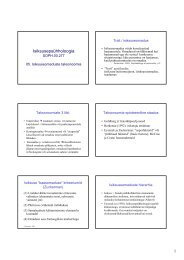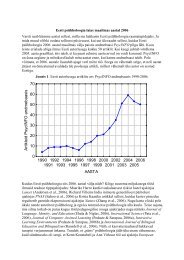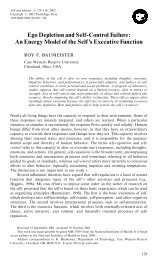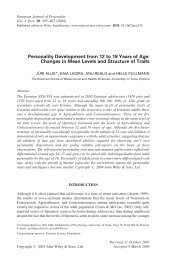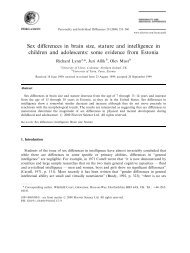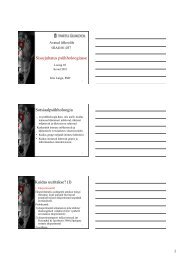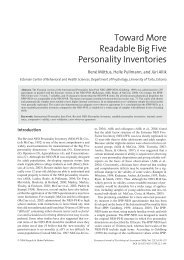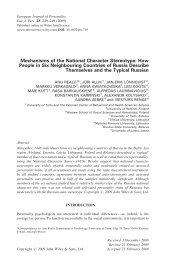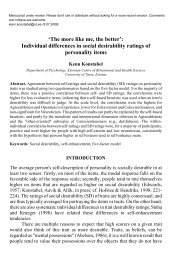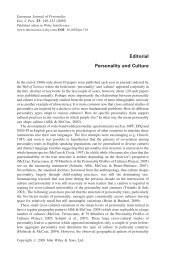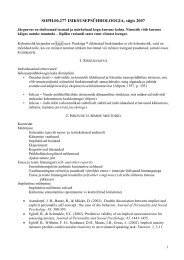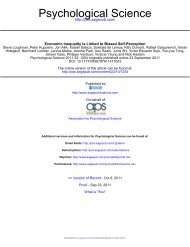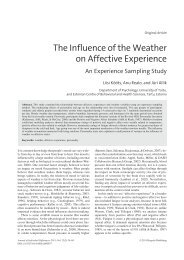History of experimental psychology from an ... - IngentaConnect
History of experimental psychology from an ... - IngentaConnect
History of experimental psychology from an ... - IngentaConnect
You also want an ePaper? Increase the reach of your titles
YUMPU automatically turns print PDFs into web optimized ePapers that Google loves.
Psychological Research (2007) 71: 618–625<br />
DOI 10.1007/s00426-006-0051-9<br />
ORIGINAL ARTICLE<br />
Jüri Allik<br />
<strong>History</strong> <strong>of</strong> <strong>experimental</strong> <strong>psychology</strong> <strong>from</strong> <strong>an</strong> Estoni<strong>an</strong> perspective<br />
Received: 2 February 2005 / Accepted: 29 November 2005 / Published online: 26 April 2006<br />
© Springer-Verlag 2006<br />
Abstract A short review <strong>of</strong> the development <strong>of</strong> <strong>experimental</strong><br />
<strong>psychology</strong> <strong>from</strong> <strong>an</strong> Estoni<strong>an</strong> perspective is presented.<br />
The Wrst rector after the reopening <strong>of</strong> the<br />
University <strong>of</strong> Dorpat (Tartu) in 1802, Georg Friedrich<br />
Parrot (1767–1852) was interested in optical phenomena<br />
which he attempted to explain by introducing the concept<br />
<strong>of</strong> unconscious inferences, <strong>an</strong>ticipating a similar<br />
theory proposed by Herm<strong>an</strong> von Helmholtz 20 years<br />
later. One <strong>of</strong> the next rectors, Alfred Wilhelm Volkm<strong>an</strong>n<br />
(1800–1878) was regarded by Edwin Boring as one <strong>of</strong><br />
the founding fathers <strong>of</strong> the <strong>experimental</strong> <strong>psychology</strong>.<br />
Georg Wilhelm Struve (1793–1864) played <strong>an</strong> essential<br />
part in solving the problem <strong>of</strong> personal equations.<br />
Arthur Joachim von Oettingen (1836–1920) developed a<br />
theory <strong>of</strong> music harmony, which stimulated his student<br />
Wilhelm Friedrich Ostwald (1853–1932) to study colour<br />
harmony. Emil Kraepelin (1856–1926), the founder <strong>of</strong><br />
modern psychiatry, is by far the most import<strong>an</strong>t <strong>experimental</strong><br />
psychologist who has worked in Estonia. His<br />
successor Wladimir von Tchisch (1855–1922), <strong>an</strong>other<br />
student <strong>of</strong> Wilhelm Wundt, continued Kraepelin’s work<br />
in <strong>experimental</strong> <strong>psychology</strong>. The lives <strong>of</strong> Wolfg<strong>an</strong>g<br />
Köhler (1887–1967), who was born in Reval (Tallinn),<br />
<strong>an</strong>d Oswald Külpe (1862–1915), who graduated <strong>from</strong><br />
the University <strong>of</strong> Dorpat, extended the link between the<br />
history <strong>of</strong> <strong>experimental</strong> <strong>psychology</strong> <strong>an</strong>d Estonia. Karl<br />
Gustav Girgensohn (1875–1925), the founder <strong>of</strong> the<br />
Dorpat School <strong>of</strong> the <strong>psychology</strong> <strong>of</strong> religion, stretched<br />
the use <strong>of</strong> <strong>experimental</strong> methods to the study <strong>of</strong> religious<br />
experience.<br />
Introduction<br />
Perhaps it was not pure ch<strong>an</strong>ce that <strong>an</strong> event like the<br />
Germ<strong>an</strong>–Estoni<strong>an</strong> symposium on <strong>experimental</strong> <strong>psychology</strong><br />
was possible at all, <strong>an</strong>d that it took place on one <strong>of</strong><br />
the most idyllic places in Estonia, the isl<strong>an</strong>d <strong>of</strong> Hiiumaa.<br />
My goal in this article is to demonstrate that m<strong>an</strong>y scholars<br />
who were born, lived or worked in Estonia took <strong>an</strong><br />
active part in the birth <strong>of</strong> <strong>experimental</strong> <strong>psychology</strong> in the<br />
nineteenth century <strong>an</strong>d in its later development. From a<br />
historical point <strong>of</strong> view, Estonia’s geographical location<br />
is far <strong>from</strong> fortunate. The fact that such a small nation<br />
with <strong>an</strong> obscure non-Europe<strong>an</strong> l<strong>an</strong>guage survived after<br />
all appears almost as a demographic accident. From <strong>an</strong><br />
intellectual viewpoint, however, the location <strong>of</strong> Estonia<br />
may even have had some adv<strong>an</strong>tages. Its marginal position<br />
set Estonia into a situation where the dialogue<br />
between diVerent l<strong>an</strong>guages <strong>an</strong>d viewpoints was not only<br />
<strong>an</strong> expression <strong>of</strong> intellectual sophistication but also a<br />
matter <strong>of</strong> survival. The history <strong>of</strong> <strong>experimental</strong> <strong>psychology</strong><br />
clearly demonstrates that the remote corner as to<br />
which Estonia had to be seen constituted <strong>an</strong> inseparable<br />
part <strong>of</strong> the Germ<strong>an</strong> speaking academic world. Herm<strong>an</strong>n<br />
von Helmholtz in his inaugural lecture as Rector <strong>of</strong> the<br />
University <strong>of</strong> Berlin talked about the academic freedom<br />
<strong>of</strong> Germ<strong>an</strong> universities <strong>an</strong>d stressed that one m<strong>an</strong>ifestation<br />
<strong>of</strong> it was a complete freedom <strong>of</strong> movement for the<br />
students between all universities <strong>of</strong> the Germ<strong>an</strong> tongue,<br />
<strong>from</strong> Dorpat to Zurich, Vienna, <strong>an</strong>d Graz (Helmholtz,<br />
1896, p. 201).<br />
J. Allik<br />
Department <strong>of</strong> Psychology, The Estoni<strong>an</strong> Centre<br />
<strong>of</strong> Behavioural <strong>an</strong>d Health Sciences, University <strong>of</strong> Tartu,<br />
Tiigi 78, Tartu, 50410, Estonia<br />
E-mail: juri.allik@ut.ee<br />
Tel.: +372-7-375905<br />
Fax: +372-7-375900<br />
Georg Friedrich Parrot <strong>an</strong>d the theory <strong>of</strong> unconscious<br />
inferences<br />
Although the University <strong>of</strong> Tartu was founded in 1632<br />
by the decree <strong>of</strong> the Swedish King Gustavus II Adolphus,<br />
it ceased to exist in 1710 after the Swedish defeat at<br />
Poltava when two Baltic provinces, Livl<strong>an</strong>d <strong>an</strong>d Estl<strong>an</strong>d<br />
(Drechsler & Kattel, 2000), were incorporated into
619<br />
Russi<strong>an</strong> empire. The University <strong>of</strong> Tartu again, then<br />
known as Dorpat, was reopened by a decree <strong>of</strong> Alex<strong>an</strong>der<br />
I, issued April 12, 1801, <strong>an</strong>d Georg Friedrich Parrot<br />
(1767–1852) became the Wrst rector <strong>of</strong> the Imperial University<br />
<strong>of</strong> Dorpat, being elected by the University Council<br />
consisting <strong>of</strong> all chaired pr<strong>of</strong>essors.<br />
Although Parrot’s brilli<strong>an</strong>t administrative skills outweighed<br />
his achievements in physics, he was <strong>an</strong> adv<strong>an</strong>ced<br />
theoretical physicist. During his lifetime, the line between<br />
physics <strong>an</strong>d <strong>psychology</strong> was very thin. In the second volume<br />
<strong>of</strong> his textbook <strong>of</strong> theoretical physics he described,<br />
within the framework <strong>of</strong> optical phenomena, problems,<br />
which without a doubt belong to the category <strong>of</strong> hum<strong>an</strong><br />
perception (Parrot, 1811). For example, one <strong>of</strong> his<br />
favourite subjects was a mech<strong>an</strong>ism by which the dist<strong>an</strong>ce<br />
<strong>of</strong> objects could be estimated. Parrot also discussed<br />
a method by which the duration <strong>of</strong> visual impression c<strong>an</strong><br />
be measured. The method by itself was not new <strong>an</strong>d was<br />
earlier known to Ibn al-Hayatam (Alhazen) <strong>an</strong>d<br />
Leonardo da Vinci (Wade, 1998, p. 195). If one rotates a<br />
rod glowing at one end with suYcient speed, the perceived<br />
trace <strong>of</strong> light seemed to form <strong>an</strong> uninterrupted circle.<br />
Because the glowing tip <strong>of</strong> the rod c<strong>an</strong>not be in all<br />
places simult<strong>an</strong>eously, it must me<strong>an</strong> that the duration <strong>of</strong><br />
sensory impression lasts until the rod makes the full turn.<br />
Thus, Parrot concluded, it is possible to determine the<br />
duration <strong>of</strong> sensory impressions. According to Parrot’s<br />
observations, the duration <strong>of</strong> sensory impression is<br />
about a quarter <strong>of</strong> the second in the dark <strong>an</strong>d about 1/<br />
6th <strong>of</strong> the second in the light (Parrot, 1820), which is one<br />
<strong>of</strong> the Wrst indications that the perceptual latency<br />
depends on overall illumination. This last value is very<br />
close to a Wgure reported by the Chevalier Patrice d‘Arcy<br />
(1725–1775), who did similar experiments in 1765<br />
(Ramul, 1963; Wade, 1998, p. 196). Both values correspond<br />
closely to those obtained later with much more<br />
sophisticated <strong>experimental</strong> devices.<br />
In September 1839, Parrot published a short note<br />
about a peculiar visual phenomenon he had observed in<br />
a fast-moving train commuting between Pavlovsk <strong>an</strong>d<br />
St. Petersburg, namely the relative diminishing <strong>of</strong> the size<br />
<strong>of</strong> external objects, situated at a relatively small dist<strong>an</strong>ce<br />
<strong>from</strong> the train window (Parrot, 1839). As Parrot<br />
observed, this apparent reduction <strong>of</strong> the size <strong>of</strong> objects<br />
depended upon the speed <strong>of</strong> their movement. When the<br />
speed <strong>of</strong> the train attained its ordinary maximum, wardhouses<br />
<strong>an</strong>d men, situated close to the train, seemed to<br />
have only half <strong>of</strong> their regular size, <strong>an</strong>d one might have<br />
the impression, as Parrot put it Wguratively, <strong>of</strong> being<br />
tr<strong>an</strong>sported through a l<strong>an</strong>d <strong>of</strong> dwarfs. As the speed <strong>of</strong> the<br />
train lowered, the men <strong>an</strong>d buildings grew in size, <strong>an</strong>d<br />
when the speed was 10 or 15 ft per second, the objects<br />
appeared approximately in their ordinary size. It seems<br />
that Parrot’s observations were never conWrmed by other<br />
researchers, but the expl<strong>an</strong>ation he gave to the str<strong>an</strong>ge<br />
perceptual phenomenon contained a pr<strong>of</strong>ound insight<br />
(Allik & Konstabel, 2005).<br />
Parrot beg<strong>an</strong> his expl<strong>an</strong>ation with reference to the<br />
size const<strong>an</strong>cy mech<strong>an</strong>ism: although the size <strong>of</strong> the<br />
retinal image is known to decrease proportionally to the<br />
viewing dist<strong>an</strong>ce, the perceived size remains unaltered.<br />
One <strong>of</strong> the mech<strong>an</strong>isms by which the dist<strong>an</strong>ce c<strong>an</strong> be<br />
measured is to count the objects between the object <strong>an</strong>d<br />
the eye. It seems that for Parrot it was self-evident that<br />
the perceived size was a result <strong>of</strong> syllogistic reasoning:<br />
<strong>from</strong> the recorded retinal size <strong>an</strong>d dist<strong>an</strong>ce (minor premise)<br />
<strong>an</strong>d the inverse proportion rule <strong>of</strong> retinal projection<br />
(major premise), <strong>an</strong> inference about the size c<strong>an</strong> be<br />
made. This decision is made very rapidly <strong>an</strong>d subjectively;<br />
we consider the time necessary for these operations<br />
to be inWnitely short, so we are not even aware <strong>of</strong><br />
their very existence. According to Parrot, the soul does<br />
not have the time to judge the dist<strong>an</strong>ce <strong>an</strong>d visual <strong>an</strong>gle<br />
with the required accuracy. Due to the rapid movement<br />
<strong>of</strong> the locomotive the soul c<strong>an</strong>not distinguish all the<br />
external objects that are required for the reliable estimation<br />
<strong>of</strong> dist<strong>an</strong>ce. Thus, the judgment that our soul makes<br />
with regard to the size <strong>of</strong> the objects in these extreme<br />
conditions is based on a preliminary false judgment—the<br />
minor <strong>of</strong> two premises is false. In other words, it is evident<br />
Parrot was formulating, here, the concept <strong>of</strong> unconscious<br />
inferences which is better known as the concept <strong>of</strong><br />
unbewusster Schluss formulated by Herm<strong>an</strong>n von<br />
Helmholtz—the psychic activities that lead us to infer<br />
that in front <strong>of</strong> us, at a certain place, there is a certain<br />
object <strong>of</strong> a certain character (Helmholtz, 1910). However,<br />
in the year <strong>of</strong> Parrot’s publication, Helmholtz was<br />
only 18 years old <strong>an</strong>d would write his H<strong>an</strong>dbuch der<br />
Physiologischen Optik only 20 years later. According to<br />
Boring, Helmholtz obviously adopted the idea <strong>of</strong> unconscious<br />
inferences while he was in Königsberg <strong>an</strong>d<br />
exposed its essentials in a lecture that was published in<br />
1855 (Boring, 1957, p. 315). Although the hypothesis <strong>of</strong><br />
unconscious inferences was implicit in this paper, it was<br />
not named as such <strong>an</strong>d was later elaborated by Wilhelm<br />
Wundt in his Beiträge zur Theorie der Sinneswahrnehmung<br />
(Wundt, 1858).<br />
Parrot was not the Wrst to suggest the existence <strong>of</strong> the<br />
involuntary reasoning-like operations in order to reach a<br />
satisfactory expl<strong>an</strong>ation <strong>of</strong> certain phenomena in the<br />
hum<strong>an</strong> perception (HatWeld, 2002). For example, Alhazen’s<br />
theory <strong>of</strong> “unconscious inferences” resembles<br />
Helmholtz’ theory <strong>of</strong> unbewusster Schluss practically in<br />
all import<strong>an</strong>t details (Bauer, 1911). According to Alhazen,<br />
perceptual judgments occur in <strong>an</strong> extremely short<br />
interval <strong>of</strong> time. The faculty <strong>of</strong> perceptual judgment does<br />
not syllogize by ordering <strong>an</strong>d composing words, that faculty<br />
perceived the conclusion without need for words or<br />
for repeating <strong>an</strong>d ordering premises (II 26b) (Sabra,<br />
1989, p. xxcvi–xcvii).<br />
One remarkable aspect <strong>of</strong> Parrot’s article was a proposed<br />
pl<strong>an</strong> <strong>of</strong> <strong>an</strong> experiment by which it is possible to<br />
determine the time that the soul uses to form its ideas<br />
<strong>an</strong>d make judgments. The idea was to make systematic<br />
observations on the apparent size <strong>of</strong> locomotives moving<br />
at a given speed <strong>an</strong>d placing objects at diVerent<br />
measured dist<strong>an</strong>ces. This <strong>experimental</strong> pl<strong>an</strong>, irrespective<br />
<strong>of</strong> its actual accomplishment, clearly recognises the
620<br />
possibility <strong>of</strong> subjecting psychological processes to<br />
<strong>experimental</strong> study, contrary to K<strong>an</strong>t’s inXuential opinion<br />
that no such thing is possible (HatWeld, 1998).<br />
So, although the notion <strong>of</strong> unconscious inference was<br />
conceptualised nine centuries earlier by Alhazen <strong>an</strong>d<br />
independently became re-invented by Parrot m<strong>an</strong>y years<br />
before Helmholtz <strong>an</strong>d Wundt articulated <strong>an</strong>d coined the<br />
doctrine <strong>of</strong> unconscious inferences, it is Helmholtz <strong>an</strong>d<br />
Wundt who are usually credited for the achievement <strong>an</strong>d<br />
not Alhazen. Aside <strong>from</strong> the concept <strong>of</strong> unconscious<br />
inferences itself, Parrot had the idea that the speed <strong>of</strong><br />
mental processes is not inWnitely high <strong>an</strong>d that in principle,<br />
it c<strong>an</strong> be determined by systematic observations <strong>of</strong><br />
phenomena <strong>of</strong> the type he observed in the moving train.<br />
His way <strong>of</strong> thinking is in harmony with Fechner,<br />
Helmholtz <strong>an</strong>d Wundt, who all, in one or <strong>an</strong>other way,<br />
demonstrated that sensory judgments c<strong>an</strong> be qu<strong>an</strong>tiWed,<br />
that a measurable qu<strong>an</strong>tity <strong>of</strong> time is required for their<br />
execution, <strong>an</strong>d that they are related to events in the physical<br />
environment in a me<strong>an</strong>ingful way. Parrot shared the<br />
conviction <strong>of</strong> the founding fathers <strong>of</strong> <strong>psychology</strong> that it<br />
is possible to study the phenomena <strong>of</strong> mind in the same<br />
general way that the physical world is studied <strong>an</strong>d c<strong>an</strong> be<br />
described in terms <strong>of</strong> either mech<strong>an</strong>ical or mathematical<br />
laws (Allik & Konstabel, 2005).<br />
The personal equation <strong>an</strong>d Friedrich Struve<br />
In 1811, Parrot org<strong>an</strong>ised a special stipend for a talented<br />
philology graduate, Friedrich Georg Wilhelm Struve<br />
(1793–1864), to continue his studies in a completely new<br />
direction—mathematics <strong>an</strong>d astronomy. Only a few<br />
years later, in 1813, Struve had became the director <strong>of</strong><br />
the Dorpat observatory, <strong>an</strong>d exactly in the same year a<br />
new observatory was erected in Königsberg under the<br />
supervision <strong>of</strong> Friedrich Wilhelm Bessel (1784–1846). In<br />
order to improve the precision <strong>of</strong> astronomical observations,<br />
Bessel proposed to calibrate observers by establishing<br />
their, as it came to be called, personal equations.<br />
In 1820, Bessel performed at Königsberg one <strong>of</strong> the most<br />
import<strong>an</strong>t experiments in the whole history <strong>of</strong> <strong>experimental</strong><br />
<strong>psychology</strong>. He <strong>an</strong>d his assist<strong>an</strong>t Walbeck Wrst<br />
selected ten stars, <strong>an</strong>d then they independently observed<br />
the tr<strong>an</strong>sit <strong>of</strong> Wve <strong>of</strong> them in one night <strong>an</strong>d <strong>of</strong> the remaining<br />
Wve in the following night, <strong>an</strong>d so on, for Wve nights.<br />
Bessel was always found to observe the tr<strong>an</strong>sit earlier<br />
th<strong>an</strong> Wallbeck. The two observers diVered systematically<br />
by about 1 s, a time diVerence that was even larger th<strong>an</strong><br />
that found between the observations <strong>of</strong> the Astronomer<br />
Royal Nevil Maskelyne <strong>an</strong>d his assist<strong>an</strong>t David Kinnebrook,<br />
particip<strong>an</strong>ts in one <strong>of</strong> the most famous incidents<br />
in the prehistory <strong>of</strong> the <strong>experimental</strong> <strong>psychology</strong><br />
(Boring, 1957). In 1823, Bessel had <strong>an</strong> opportunity to<br />
repeat a similar comparison with <strong>an</strong>other assist<strong>an</strong>t Argel<strong>an</strong>der.<br />
Again, a systematic diVerence was found between<br />
the two observers. This convinced Bessel that there are<br />
irreducible individual diVerences between observers.<br />
Even if a given observer was consistent with himself on<br />
diVerent trials, his me<strong>an</strong> judgment time systematically<br />
disagrees with the same judgment made by <strong>an</strong>other<br />
observer. To verify these observations, Bessel was especially<br />
eager to compare himself with Struve in Dorpat,<br />
who already had earned a reputation as being one <strong>of</strong> the<br />
best astronomical observers. Having no opportunity for<br />
a direct comparison, Bessel sent three <strong>of</strong> his assist<strong>an</strong>ts<br />
Walbeck 1 , Argel<strong>an</strong>der 2 <strong>an</strong>d Knorre to Dorpat in 1821,<br />
1823 <strong>an</strong>d 1825, respectively, to compare their observation<br />
data with Struve. Through them, Bessel established<br />
indirectly the relation between the personal observation<br />
times between himself <strong>an</strong>d Struve. Only in 1834 did Bessel<br />
<strong>an</strong>d Struve Wnd <strong>an</strong> opportunity to compare themselves<br />
directly <strong>an</strong>d conWrm the indirect predictions<br />
(Boring, 1957, p. 137). 3<br />
The further history <strong>of</strong> this problem is well known: in<br />
1861, Wilhelm Wundt constructed his famous pendulum,<br />
also known as Wundt’s complication clock, that swung<br />
across a scale <strong>an</strong>d caused a spring to give a click at a<br />
given point <strong>of</strong> excursion. The basic design reproduced<br />
essential properties <strong>of</strong> Bradley’s “eye <strong>an</strong>d ear” method<br />
(cf. Boring, 1957, p. 135) that was used for astronomical<br />
measurements. The Wrst series <strong>of</strong> experiments on compound<br />
reaction (Boring, 1957, p. 324) were conducted by<br />
Max Friedrich in the Wrst psychological laboratory<br />
founded by Wundt in 1879 (Dom<strong>an</strong>ski, 2004).<br />
There is no evidence about Friedrich Struve’s direct<br />
contribution to the problem <strong>of</strong> the personal equations<br />
besides the practical use <strong>of</strong> it. However, it was the communication<br />
between Königsberg <strong>an</strong>d Dorpat that helped<br />
to discover measurable individual diVerences between<br />
hum<strong>an</strong> observers, which belongs, despite <strong>of</strong> its seeming<br />
triviality, to one <strong>of</strong> the most consequential discoveries in<br />
the whole history <strong>of</strong> <strong>psychology</strong>.<br />
Alfred Volkm<strong>an</strong>n <strong>an</strong>d Weber’s Law<br />
Gustav Theodor Fechner’s Elemente der Psychophysics,<br />
published in 1860, established a solid foundation for<br />
<strong>experimental</strong> <strong>psychology</strong>. As Boring noticed, “with<br />
Fechner it was born, quite as old, <strong>an</strong>d also quite as<br />
1<br />
In 1821, H. J. Walbeck (1794–1823) was <strong>an</strong> astronomer in Turku,<br />
Finl<strong>an</strong>d <strong>an</strong>d he died only 2 years later at the age <strong>of</strong> 29. In 1819, he<br />
calculated dimensions <strong>of</strong> the Earth which were very close to the correct<br />
values known today.<br />
2<br />
Friedrich Wilhelm August Argel<strong>an</strong>der (1799–1875) later became<br />
director <strong>of</strong> the observatory at the University <strong>of</strong> Bonn.<br />
3<br />
There are few errors in the name index <strong>of</strong> otherwise accurate Boring’s<br />
<strong>History</strong> (Boring, 1957). He is referring to Struve as O.W. Struve<br />
which is certainly wrong. The correct reference should be Friedrich<br />
Georg Wilhelm Struve whose son Otto Wilhelm was not even born<br />
when the Wrst personal equation was determined. The reverse error<br />
has happened with regard to Knorre. Boring erroneously thinks that<br />
Bessel wrote about Ernst Christoph Friedrich Knorre (1759–1810)<br />
who was also <strong>an</strong> astronomer, but he had died 15 years ago when his<br />
son Karl Freidrich Knorre visited Königsberg in 1825 (cf. Petrov &<br />
Pinigin, 2002).
621<br />
4<br />
Rudolf Wagner’s son, Adolf Wagner (1835–1917) was a pr<strong>of</strong>essor<br />
<strong>of</strong> Dorpat University (1865–1868) known as the central theorist <strong>of</strong><br />
‘state socialism’ (Drechsler, 1997).<br />
young, as a baby” (Boring 1957, p. 275). Fechner had, <strong>of</strong><br />
course, predecessors including Ernst Weber after whom<br />
Fechner named “Weber’s law”. Ernst Heinrich Weber<br />
(1795–1878) was a pr<strong>of</strong>essor <strong>of</strong> <strong>an</strong>atomy <strong>an</strong>d physiology<br />
at Leipzig <strong>from</strong> 1818 <strong>an</strong>d thereafter. Fechner considered<br />
Weber’s law as a cornerstone <strong>from</strong> which he could move<br />
forward to derive his psychophysical law simply by logical<br />
deduction. Therefore, it was the greatest import<strong>an</strong>ce<br />
to establish the universality <strong>of</strong> the Weber’s law beyond<br />
tactual perception <strong>from</strong> where it was established Wrst.<br />
At the time when young Fechner got his degree in<br />
medicine in 1822, <strong>an</strong>other young m<strong>an</strong>, Alfred Wilhelm<br />
Volkm<strong>an</strong>n (1800–1878) enrolled as a student <strong>of</strong> medicine<br />
at Leipzig in 1821. Together with Rudolph Herm<strong>an</strong>n<br />
Lotze (1817–1881) Fechner <strong>an</strong>d Volkm<strong>an</strong>n formed a<br />
small intellectual group, which dissolved only in 1837<br />
when Volkm<strong>an</strong>n received his pr<strong>of</strong>essorship in Dorpat<br />
(Boring, 1957, p. 277). Four years earlier, in 1833,<br />
Fechner had married Volkm<strong>an</strong>n’s sister.<br />
The role <strong>of</strong> Volkm<strong>an</strong>n in the development <strong>of</strong> psychophysics<br />
is generally acknowledged. Usually it is mentioned<br />
that “in co-operation with Volkm<strong>an</strong>n, Fechner<br />
developed the method <strong>of</strong> “average error” (already in use<br />
in astronomy) for use in visual <strong>an</strong>d tactual measurement”<br />
(Murphy, 1964, p. 90). It is, however, import<strong>an</strong>t to<br />
note that the role <strong>of</strong> Volkm<strong>an</strong>n was not only to assist<br />
Fechner, but in 1864, Volkm<strong>an</strong>n also reported independently<br />
that the threshold for length discrimination<br />
increases with the increase <strong>of</strong> the reference length. This<br />
was one <strong>of</strong> the Wrst demonstrations <strong>of</strong> Weber’s law in the<br />
visual domain. This fundamental Wnding about dist<strong>an</strong>ce<br />
judgment—Weber’s law for spatial intervals—has been<br />
replicated repeatedly since then, for a variety <strong>of</strong> stimuli<br />
<strong>an</strong>d response modes, <strong>an</strong>d was proved to be one <strong>of</strong> the few<br />
Wrmly established <strong>an</strong>d replicable facts <strong>of</strong> <strong>psychology</strong> (cf.<br />
Burbeck & Hadden, 1993). Volkm<strong>an</strong>n, like Fechner<br />
before him, was also interested in the tr<strong>an</strong>sfer <strong>of</strong> training.<br />
Fechner was one <strong>of</strong> the Wrst who reported data showing<br />
that learning to write with one h<strong>an</strong>d facilitates the same<br />
activity with the other h<strong>an</strong>d. In his studies, he was again<br />
able to relay on previous studies done by Volkm<strong>an</strong>n who<br />
demonstrated <strong>experimental</strong>ly that the reduction <strong>of</strong> the<br />
“two-point” threshold in certain regions through training<br />
lowered the threshold in other regions as well (cf.<br />
Murphy 1964, p. 241). He also determined the speed <strong>of</strong><br />
eye movements <strong>an</strong>d constructed the Wrst prototype <strong>of</strong> the<br />
tachistoscope (Volkm<strong>an</strong>n, 1859). Volkm<strong>an</strong>n also wrote a<br />
section on vision in Wagner’s. 4 H<strong>an</strong>dwörterbuch der<br />
Physiologie, which became a st<strong>an</strong>dard textbook for the<br />
next half <strong>of</strong> a century. Among other observations, he<br />
repeated his earlier expl<strong>an</strong>ation to upright vision: the<br />
most natural expl<strong>an</strong>ation <strong>of</strong> upright vision is that it does<br />
not require <strong>an</strong> expl<strong>an</strong>ation (Volkm<strong>an</strong>n, 1836, p. 41).<br />
Perhaps Volkm<strong>an</strong>n’s most import<strong>an</strong>t contribution to<br />
<strong>experimental</strong> <strong>psychology</strong> concerns not only visual physiology<br />
but also principles <strong>of</strong> operation <strong>of</strong> the whole nervous<br />
system. In 1832, he published in Müller’s Archiv, a<br />
study in which he demonstrated the inhibitory role <strong>of</strong> the<br />
vagus nerve on cardiac activity. Usually the discovery <strong>of</strong><br />
a entirely new kind <strong>of</strong> nervous action—inhibition—is<br />
credited to Volkm<strong>an</strong>n’s teachers in Leipzig University,<br />
the Weber brothers (Fulton, 1930, p. 276; Singer &<br />
Underwood, 1962, p. 331). It was claimed that Volkm<strong>an</strong>n<br />
just “missed <strong>an</strong> import<strong>an</strong>t opportunity”. Volkm<strong>an</strong>n himself<br />
never regarded the observed eVect as some technical<br />
error or <strong>an</strong> uninteresting observation. He realised the<br />
import<strong>an</strong>ce <strong>of</strong> his discovery despite the domin<strong>an</strong>t belief<br />
that activation could only lead to the increase <strong>of</strong> nervous<br />
activity (Käbin, 1986, p. 79).<br />
Helmholtz paid respect to Volkm<strong>an</strong>n <strong>an</strong>d cited his<br />
work in his H<strong>an</strong>dbook <strong>of</strong> Physiological Optics (1867) 58<br />
times (Piper, 2000). Therefore, it is not surprising that<br />
Boring listed Volkm<strong>an</strong>n beside Helmholtz <strong>an</strong>d Fechner<br />
as one <strong>of</strong> the “founding fathers” <strong>of</strong> the <strong>experimental</strong> <strong>psychology</strong><br />
(Boring, 1957, p. 384).<br />
Arthur Joachim von Oettingen <strong>an</strong>d the system <strong>of</strong> harmony<br />
Arthur Joachim von Oettingen (1836–1920) was the oldest<br />
<strong>of</strong> the six Oettingen brothers. Like his two other<br />
brothers, he became a pr<strong>of</strong>essor <strong>of</strong> Tartu University at<br />
age 31. Besides physics, which was his main subject, he<br />
was particularly interested in music <strong>an</strong>d held a special<br />
course on the perception <strong>of</strong> music. He summarised his<br />
explorations in a book called Das Harmoniesystem in<br />
duale Entwicklung which was recognised by musical theorists<br />
at that time (Oettingen, 1866). Herm<strong>an</strong>n von<br />
Helmholtz, for example, was particularly interested in<br />
Oettingen’s report according to which the old modal<br />
song tradition was still alive <strong>an</strong>d strong among<br />
Estoni<strong>an</strong>s; they had diYculties to master the Protest<strong>an</strong>t<br />
plainsong, common in Europe, because <strong>of</strong> its high leading<br />
tone (Ross, 1991). It is interesting that in the principal<br />
dispute between August Seebeck 5 <strong>an</strong>d Helmholtz,<br />
concerning the question whether the perceived pitch is<br />
determined by the objective Fourier components or not,<br />
Oettingen rather took the position <strong>of</strong> his countrym<strong>an</strong><br />
rather th<strong>an</strong> Helmholtz’s. In his theory <strong>of</strong> conson<strong>an</strong>ce <strong>an</strong>d<br />
disson<strong>an</strong>ce Oettingen, like Seebeck before him, proposed<br />
that higher harmonics c<strong>an</strong> collaborate in the creation <strong>of</strong><br />
the perceived pitch which could depart <strong>from</strong> the physically<br />
present or absent fundamental tone. Ernst Mach,<br />
for example, used Oettingen’s harmony theory as a<br />
5<br />
August Seebeck’s farther, Thomas Seebeck (1770–1831) was born<br />
in Tallinn <strong>an</strong>d, despite the fact that he spent the most part <strong>of</strong> his life<br />
in Germ<strong>an</strong>y, was estimated by his contemporaries as belonging to<br />
the Baltic Germ<strong>an</strong> elite not only due to his famous career as a physicist<br />
but also due to his close friendship with Goethe. Thomas Seebeck<br />
is known in the history <strong>of</strong> physics with his seminal works in<br />
thermo-electricity. He also discovered several new entoptic color<br />
phenomena (Ross, 1991).
622<br />
subst<strong>an</strong>tial evidence against Helmholtz’ acoustic theory<br />
(Mach, 1922, p. 222).<br />
It is certainly not a coincidence that one <strong>of</strong> Oettingen’s<br />
students Wilhelm Friedrich Ostwald (1853–1932)<br />
winner <strong>of</strong> the Nobel Prize in chemistry in 1909 was also<br />
interested in the <strong>an</strong>alysis <strong>of</strong> music <strong>an</strong>d art. As Ostwald<br />
writes in his memories he attended Oettingen’s lectures<br />
on <strong>psychology</strong> <strong>of</strong> music <strong>an</strong>d was particularly inspired by<br />
his theory <strong>of</strong> harmony, which contained several fundamental<br />
discoveries. Although Ostwald found Harmoniesystem<br />
inspiring it was in his opinion written in such<br />
obscure m<strong>an</strong>ner that nobody has really m<strong>an</strong>aged to read<br />
it, except the author himself <strong>an</strong>d the typesetter. Inspired<br />
by Oettingen’s lectures Ostwald himself tried to apply<br />
qu<strong>an</strong>titative methods to the <strong>an</strong>alysis <strong>of</strong> Beethoven’s<br />
pi<strong>an</strong>o sonatas (Ostwald, 1926). Unfortunately, Ostwald’s<br />
studies in musical harmony are not widely known <strong>an</strong>d<br />
have been overshadowed by his more celebrated studies<br />
on colour harmony (Ostwald, 1918). In 1927, Ostwald<br />
even lectured in the Bauhaus School <strong>of</strong> art <strong>an</strong>d made a<br />
strong impression on Wassily K<strong>an</strong>dinsky (Ball, 2003).<br />
Emil Kraepelin <strong>an</strong>d <strong>experimental</strong> <strong>psychology</strong><br />
Emil Kraepelin (Neustrelitz, Germ<strong>an</strong>y, 1856—München,<br />
1926) is by far the most import<strong>an</strong>t <strong>experimental</strong> psychologist<br />
who has been associated with Estonia. The founder<br />
<strong>of</strong> modern psychiatry he became pr<strong>of</strong>essor <strong>of</strong> psychiatry<br />
at Dorpat University in 1886 when he was 30 years old<br />
(Steinberg & Angermeyer, 2001). It was Wundt who suggested<br />
to his favourite student about medical vocation<br />
instead <strong>of</strong> the uncertainties <strong>of</strong> being a psychologist. In his<br />
Memoirs Kraepelin summarises his years in Tartu in the<br />
following way: “...besides my clinical training I was able<br />
to hold quite a number <strong>of</strong> independent lectures about<br />
criminal <strong>psychology</strong>, forensic psychiatry, about the conscience<br />
<strong>an</strong>d its disorders <strong>an</strong>d <strong>experimental</strong> <strong>psychology</strong>.<br />
There was never lack <strong>of</strong> students for these lectures. I considered<br />
psychological discussions, based on Wundt’s<br />
model, to be specially import<strong>an</strong>t <strong>an</strong>d I made the students<br />
make reports on individual problems” (Kraepelin, 1987,<br />
p. 42). As he later confessed, <strong>experimental</strong> work appealed<br />
to him much more th<strong>an</strong> clinical work (Kraepelin, 1987, p.<br />
42). There were two main reasons to be not satisWed with<br />
his clinical work: the Wrst was the l<strong>an</strong>guage barrier 6 <strong>an</strong>d<br />
the second was the insuYcient number <strong>of</strong> patients.<br />
Therefore, fortunately to <strong>psychology</strong>, he concentrated on<br />
<strong>psychology</strong>. He wrote about it:<br />
The conditions for starting a school <strong>of</strong> <strong>psychology</strong> in<br />
Dorpat were favourable. The distinguished physiologist,<br />
6<br />
His knowledge <strong>of</strong> Estoni<strong>an</strong> was quite enough to make a tremendous<br />
impression on the personell <strong>of</strong> the Ist<strong>an</strong>bul’s mental asylum he<br />
visited during one <strong>of</strong> his frequent travels. During his visit a patient<br />
was shown, whose origin was unclear, as he spoke a completely unknown<br />
l<strong>an</strong>guage. The Estoni<strong>an</strong> sailm<strong>an</strong> was, <strong>of</strong> course, very happy<br />
to Wnd someone, who could speak at least few words <strong>of</strong> his mother<br />
tongue with him (Kraepelin, 1987, p. 82).<br />
Alex<strong>an</strong>der Schmidt, had placed a room in his new institute<br />
at our disposal, which was <strong>of</strong> great help, as the clinic was<br />
too far away <strong>an</strong>d had no spare room. The university<br />
mech<strong>an</strong>ics Schulze proved to be <strong>an</strong> exceptionally skilled<br />
<strong>an</strong>d underst<strong>an</strong>ding helper <strong>an</strong>d produced a number <strong>of</strong> well<br />
invented <strong>an</strong>d carefully pl<strong>an</strong>ned machines for various investigations.<br />
Luckily, I found a lot <strong>of</strong> keen, self-sacriWcing<br />
students prepared to devote m<strong>an</strong>y, m<strong>an</strong>y months’ work<br />
solely to their doctorate theses. Thus, studies were made,<br />
which brought import<strong>an</strong>t new Wndings with them; for<br />
example the work by Michelson on the depth <strong>of</strong> sleep, individual<br />
<strong>psychology</strong> by Oehrn, time sense by Eyner, contrast<br />
sensitivity with perception <strong>of</strong> space by Higier <strong>an</strong>d the<br />
diversion <strong>of</strong> attention by Bertels. DiYculties to overcome<br />
on the technical side were <strong>of</strong>ten considerable <strong>an</strong>d I const<strong>an</strong>tly<br />
admired the patience <strong>of</strong> the youngsters in withst<strong>an</strong>ding<br />
all these obstacles. Sometimes, the physicist<br />
Arthur von Oettingen gave us his kind advice.” (Kraepelin,<br />
1987, pp. 44–45).<br />
Kraepelin found the general scientiWc life in Dorpat<br />
stimulating, as there were always a number <strong>of</strong> younger<br />
pr<strong>of</strong>essors present, who worked with enthusiasm. He<br />
wrote that with the university very near, the university<br />
members had active contact with one <strong>an</strong>other in <strong>an</strong><br />
atmosphere <strong>of</strong> unconditional equality (Kraepelin,<br />
1987, p. 47). In these conditions, Kraepelin pursued<br />
diVerent lines <strong>of</strong> investigation, including word<br />
associations:<br />
I had set up my own equipment for the measurement <strong>of</strong><br />
mental reactions <strong>an</strong>d carried out tests on aphasic <strong>an</strong>d other<br />
suitable psychiatric patients <strong>an</strong>d on m<strong>an</strong>ic patients. I made<br />
the surprising discovery that the association’s times were<br />
by no me<strong>an</strong>s shorter, but were <strong>of</strong>ten longer <strong>an</strong>d very irregular.<br />
This fact led me to underst<strong>an</strong>d that the Xight <strong>of</strong> ideas<br />
was not the accelerated consequence <strong>of</strong> mental images, but<br />
were volatile <strong>an</strong>d instable emerging processes in the conscience”<br />
(p. 44).<br />
Among psychological problems, however, the subject<br />
<strong>of</strong> Kraepelin’s special interest was fatigue. He regarded<br />
his established work curve as his chief contribution.<br />
W. Weyg<strong>an</strong>dt, who wrote <strong>an</strong> elaborate obituary in Psychologische<br />
Arbeiten, revealed that Kraepelin had hoped<br />
to receive the Nobel award not for dementia praecox or<br />
his nosological classiWcation but for his results on the<br />
work curve (Roback, 1961, p. 308).<br />
It is not surprising that today, almost a century later<br />
<strong>of</strong> his innovative studies, he remains one <strong>of</strong> the most<br />
cited behavioural scientists <strong>of</strong> all times. According to the<br />
Social Sciences Citation Index Kraepelin was cited 6,618<br />
times in the period <strong>from</strong> 1972 to 2005 (November) more<br />
th<strong>an</strong> 200£ every year.<br />
Along with the intensive RussiWcation campaign<br />
launched in 1889, the autonomy <strong>of</strong> the University <strong>of</strong><br />
Dorpat was considerably reduced: rector, de<strong>an</strong>s <strong>an</strong>d<br />
pr<strong>of</strong>essors were not elected <strong>an</strong>y more but appointed by<br />
the Minister <strong>of</strong> Education (the appointment <strong>of</strong> the rector<br />
required approval by the czar himself). Besides<br />
diminishing the role <strong>of</strong> Baltic Germ<strong>an</strong>s, one <strong>of</strong> the goals<br />
<strong>of</strong> these reforms was to prevent people <strong>from</strong> lower
623<br />
strata to study at the university. In order to achieve this<br />
goal, the study fee was increased <strong>from</strong> 10 to 50 roubles<br />
per year. Typically for the Russi<strong>an</strong> Empire, then <strong>an</strong>d<br />
later, strict quotas <strong>of</strong> Jews admitted by the universities<br />
were imposed (Siilivask, 1982, p. 258). Russi<strong>an</strong> became<br />
the oYcial l<strong>an</strong>guage <strong>of</strong> teaching <strong>an</strong>d all Germ<strong>an</strong> pr<strong>of</strong>essors<br />
who were not able or willing to lecture in Russi<strong>an</strong><br />
had to leave Tartu. Among those who had to leave<br />
Dortpat, or Jurjev, as it was renamed, were Oettingen,<br />
Ostwald, <strong>an</strong>d Kraepelin.<br />
Wladimir Tchisch as a successor <strong>of</strong> Kraepelin<br />
One <strong>of</strong> the Wrst Russi<strong>an</strong> students <strong>of</strong> Wundt, Wladimir<br />
Tchisch (1855–1922) 7 was appointed as a successor <strong>of</strong><br />
Kraepelin. When Tchisch arrived at Leipzig in 1884, he<br />
naturally was appointed to work with Wundt’s pendulum<br />
<strong>an</strong>d complication reaction. He noticed in particular<br />
that in some cases a click could be heard before the pendulum<br />
actually reached the spring; in other cases the<br />
click appeared later when the pendulum had already<br />
passed the spring (Tchisch, 1885). Since then diVerent<br />
time paradoxes fascinated philosophers as well as psychologists<br />
(cf. Dennett, 1991). For example, the apparent<br />
lagging behind <strong>of</strong> a moving object in relation to a short<br />
sound or Xash was repeatedly rediscovered <strong>an</strong>d has<br />
recently become known under the name <strong>of</strong> the Flash–<br />
Lag EVect (Nijhaw<strong>an</strong>, 1994; Kreegipuu & Allik, 2004).<br />
Concerning his teaching, Tchisch regularly held<br />
courses on <strong>experimental</strong> <strong>psychology</strong> <strong>an</strong>d supervised<br />
doctoral dissertations that had a clear <strong>experimental</strong>–<br />
psychological orientation (Ramul, 1974). From the<br />
titles <strong>of</strong> dissertations supervised by Tchisch the following<br />
c<strong>an</strong> be named: experiments concerning spatial<br />
memory <strong>of</strong> the skin (E. Loewenton, 1893); memory <strong>of</strong><br />
active movements (F. Schneider, 1894); the sense<br />
<strong>of</strong> location <strong>an</strong>d its memory (B. Barth, 1894); memory<br />
<strong>of</strong> visual perceptions (K. Zaborovsky, 1894); comparative<br />
study <strong>of</strong> tactile <strong>an</strong>d gustatory sensitivity <strong>of</strong> women<br />
<strong>from</strong> diVerent social classes (W.V. Dehm, 1894); the<br />
ch<strong>an</strong>ge <strong>of</strong> pulse <strong>an</strong>d aspiration during diVerent psychical<br />
states (G. Hirsch, 1899); <strong>an</strong> <strong>experimental</strong> study <strong>of</strong><br />
the skin sensitivity (G. Hildebr<strong>an</strong>d, 1899) (Ramul,<br />
1974, p. 107).<br />
The list <strong>of</strong> these studies characterises Tchisch’s somewhat<br />
unsystematic interests which nevertheless kept the<br />
tradition <strong>of</strong> <strong>experimental</strong> psychological investigations<br />
alive at Tartu University. Some <strong>of</strong> them, especially the<br />
inXuence <strong>of</strong> social factors on perception, <strong>an</strong>ticipated the<br />
popularity <strong>of</strong> these problems in the subsequent history <strong>of</strong><br />
<strong>psychology</strong>.<br />
7<br />
Sometimes in Russi<strong>an</strong> (me<strong>an</strong>s ‘siskin’) is also tr<strong>an</strong>scribed<br />
into the Latin alphabet as Chizh. William James’ Principles referred<br />
to him as Tschisch (James, 1890).<br />
Two <strong>experimental</strong>ists with Estoni<strong>an</strong> connections<br />
It is impossible to avoid mentioning the two psychologists<br />
who never practised their pr<strong>of</strong>ession in Estonia but<br />
were nevertheless connected to Estonia. They are<br />
Wolfg<strong>an</strong>g Köhler (1887–1967) <strong>an</strong>d Oswald Külpe (1862–<br />
1915)<br />
Wolfg<strong>an</strong>g Köhler (1887–1967), the main theoretici<strong>an</strong><br />
<strong>of</strong> gestalt <strong>psychology</strong>, was born in Tallinn (Reval) in his<br />
parents residence Toomkooli 4 (Schulgasse 9) on the 21st<br />
<strong>of</strong> J<strong>an</strong>uary, 1887 (Lõo, 2004). His farther, Fr<strong>an</strong>z Köhler,<br />
was the Headmaster <strong>of</strong> the Germ<strong>an</strong> Gymnasium (Domschule)<br />
<strong>an</strong>d his residence was just across the street. His<br />
mother, Wilhelmine Girgensohn, was a daughter <strong>of</strong> luther<strong>an</strong><br />
priest. When Köhler was about 6, the family moved<br />
to Germ<strong>an</strong>y. The main reason for leaving Estonia was<br />
again the campaign <strong>of</strong> RussiWcation which put <strong>an</strong> end to<br />
education in other l<strong>an</strong>guages rather th<strong>an</strong> Russi<strong>an</strong>.<br />
There is no need to reiterate the import<strong>an</strong>ce <strong>of</strong> Wolfg<strong>an</strong>g<br />
Köhler, one <strong>of</strong> the most distingushed psychologists<br />
<strong>of</strong> the twentieth century. Besides his illustrious pr<strong>of</strong>essional<br />
career he is <strong>an</strong> example <strong>of</strong> extraordinary personal<br />
integrity. Only few Germ<strong>an</strong> scientists <strong>an</strong>d intellectuals<br />
had the courage to protest against the dismissal <strong>of</strong> Jewish<br />
scientists after the Nazis took power in J<strong>an</strong>uary 1933.<br />
Köhler was <strong>an</strong> exception. With the dismissal <strong>of</strong> James<br />
Fr<strong>an</strong>ck, the physicist <strong>an</strong>d Nobel Prize winner in 1925,<br />
Köhler made a public statement. On April 28, 1933 he<br />
wrote for the Deutsches Allgemeine Zeitung, the last <strong>an</strong>tinazi<br />
article to be published under the Nazi regime. In this<br />
article he wrote that Fr<strong>an</strong>ck’s dismissal “shows the deepest<br />
reason why all these people are not joining the Party:<br />
they feel moral imposition. They believe that only the<br />
quality <strong>of</strong> hum<strong>an</strong> being should determine his worth, that<br />
intellectual achievement, character, <strong>an</strong>d obvious contribution<br />
to Germ<strong>an</strong> culture retain their signiWc<strong>an</strong>ce<br />
whether a person is Jewish or not” (Henle, 1978; Ash,<br />
1995, p. 326 V.).<br />
Oswald Külpe, the founder <strong>of</strong> the Würzburg School,<br />
was born near the Baltic coast in Courl<strong>an</strong>d which is now<br />
Latvia. He beg<strong>an</strong> his studies <strong>of</strong> <strong>psychology</strong> under Wundt<br />
in Leipzig but then went to Berlin for a semester to study<br />
history instead. Afterwards he returned to <strong>psychology</strong><br />
again <strong>an</strong>d studied three semesters in Göttingen with<br />
G.E. Müller who had succeeded Lotze (Boring, 1957,<br />
pp. 397–398). In 1885, however, he left Göttingen <strong>an</strong>d<br />
went to Tartu for a whole year in order to graduate as <strong>an</strong><br />
art histori<strong>an</strong>. After receiving his degree, he returned to<br />
Leipzig where he wrote, as <strong>an</strong> assist<strong>an</strong>t <strong>of</strong> Wundt, <strong>an</strong><br />
introductory textbook (Külpe, 1893). Wundt, as it is well<br />
known, was very skeptical about the possibility <strong>of</strong> studying,<br />
in a scientiWcally sound way, <strong>an</strong>ything more intricate<br />
th<strong>an</strong> elementary sensations <strong>an</strong>d simple motor responses.<br />
More complex phenomena, like feelings <strong>an</strong>d thoughts,<br />
are too Wrmly enclosed by the boundaries <strong>of</strong> the subject<br />
<strong>an</strong>d their causes are generally hidden <strong>from</strong> objective<br />
investigation. Külpe, in turn, states in his textbook that<br />
in principle there is no topic <strong>of</strong> psychological inquiry
624<br />
which c<strong>an</strong>not be approached by the <strong>experimental</strong><br />
method. And <strong>experimental</strong> <strong>psychology</strong> is therefore fully<br />
within its rights when it claims to be the general <strong>psychology</strong><br />
(Külpe, 1893). In Wundt’s view, Külpe’s approach to<br />
<strong>psychology</strong> was based on <strong>an</strong> erroneous overestimation <strong>of</strong><br />
the scope <strong>of</strong> natural science <strong>an</strong>d reduces <strong>psychology</strong> to a<br />
kind <strong>of</strong> “applied physiology” (D<strong>an</strong>ziger, 1979, p. 211). In<br />
<strong>an</strong>y case, Külpe was unwilling to follow Wundt’s recommendations<br />
<strong>an</strong>d like Ebbinghaus, who had brought<br />
memory as <strong>an</strong>other specimen <strong>of</strong> the “higher mental processes”,<br />
under the scrutiny <strong>of</strong> <strong>experimental</strong> methods,<br />
decided to bring thought into the laboratory as well<br />
(Boring, 1957, p. 402). This basic idea marked the beginning<br />
<strong>of</strong> the Würzburg School <strong>an</strong>d the breakdown <strong>of</strong><br />
<strong>an</strong>other barrier on the way <strong>of</strong> <strong>experimental</strong> <strong>psychology</strong>.<br />
Dorpat School <strong>of</strong> <strong>psychology</strong> <strong>of</strong> religion<br />
Karl Gustav Girgensohn (1875–1925) was a cousin <strong>of</strong><br />
Wolfg<strong>an</strong>g Köhler’s mother, Wilhelmine Girgensohn<br />
(Lõo, 2004). In 1903, Girgensohn returned to Dorpat<br />
after studies in Germ<strong>an</strong>y for defending his Master Thesis<br />
“The religion, its psychical form <strong>an</strong>d its central idea”<br />
(Die Religion, ihre psychischen Formen und ihre Zentralidee).<br />
Seven years later, in 1910, he obtained his doctoral<br />
degree <strong>from</strong> Berlin University. At the same year <strong>an</strong><br />
import<strong>an</strong>t event happened which ch<strong>an</strong>ged his life. He<br />
Wnally found <strong>an</strong> <strong>an</strong>swer to a question that had puzzled<br />
him: is it possible by me<strong>an</strong>s <strong>of</strong> the modern science to<br />
explain the nature <strong>of</strong> Christi<strong>an</strong>ity? A colleague at Dorpat<br />
University introduced Girgensohn to the revolutionary<br />
work <strong>of</strong> the Würzburg School (WulV, 1991, p. 554). In<br />
1910 he accepted Külpe’s invitation to spend a term with<br />
him at Bonn. Girgensohn soon became a convinced<br />
adherent <strong>of</strong> the Würzburg School procedures. He<br />
believed that the method <strong>of</strong> <strong>experimental</strong> introspection<br />
suits ideally to the study <strong>of</strong> religious experiences <strong>an</strong>d c<strong>an</strong><br />
resolve the debate <strong>of</strong> the psychological nature <strong>of</strong> religion.<br />
In 1911 Girgensohn beg<strong>an</strong> his experiments by laboriously<br />
recording the observations <strong>of</strong> 14 individuals,<br />
including himself. He presented to his subjects not very<br />
well known texts <strong>from</strong> various theological writers, <strong>an</strong>d<br />
recorded the thoughts <strong>an</strong>d feelings as they arose in his<br />
subjects while they were reading the texts. Girgensohn<br />
not only recorded the associations <strong>of</strong> his subject, but also<br />
interviewed them in order to further explore their<br />
responses to the texts. In this Wrst experiment, each particip<strong>an</strong>t<br />
was tested on 26 diVerent texts. The work lasted<br />
for 2 years <strong>an</strong>d the Wrst results <strong>of</strong> the Wrst <strong>experimental</strong><br />
study <strong>of</strong> religious experience were summarised in 1913.<br />
In 1921 his monumental book containing more th<strong>an</strong> 700<br />
pages was published (Girgensohn, 1921). Girgensohn’s<br />
ideas inspired m<strong>an</strong>y people <strong>an</strong>d as WulV (1991, p. 16)<br />
wrote: “Students <strong>an</strong>d visiting scholars found their way to<br />
Dorpat <strong>an</strong>d, after 1919, to Greifswald <strong>an</strong>d then to Leipzig,<br />
in order to work with Girgensohn”. This group <strong>of</strong><br />
people formed <strong>an</strong> intellectual unity which is still called<br />
the Dorpat School <strong>of</strong> religious <strong>psychology</strong> (WulV, 1985).<br />
After Girgensohn’s unexpected death in 1925, Werner<br />
Gruehn (1887–1961) became the leader <strong>of</strong> the Dorpat<br />
schoool. The full program <strong>of</strong> the Dorpat School is represented<br />
in the large h<strong>an</strong>dbook Contemporary Piety<br />
(Gruehn, 1956). David WulV’s (1991) most comprehensive<br />
treatise on <strong>psychology</strong> <strong>of</strong> religion devotes <strong>an</strong> entire<br />
chapter to Girgensohn <strong>an</strong>d the Dorpat School.<br />
The history <strong>of</strong> <strong>psychology</strong> c<strong>an</strong> be seen as a struggle<br />
for a deWnition <strong>of</strong> the borderline separating psychological<br />
issues allowing for <strong>an</strong> <strong>experimental</strong> approach <strong>an</strong>d<br />
issues that do not. K<strong>an</strong>t’s pessimistic dictum that “no<br />
other thinking subject c<strong>an</strong> be subjected to our experiments<br />
in accord<strong>an</strong>ce with purpose” still captivated the<br />
minds <strong>of</strong> most psychologists (Ramul, 1960). M<strong>an</strong>y areas,<br />
including that <strong>of</strong> hum<strong>an</strong> thought which Wundt believed<br />
to remain terra incognita forever, were already em<strong>an</strong>cipated<br />
<strong>from</strong> K<strong>an</strong>t’s moratorium. Religious experience, as<br />
attacked by the Dorpat School, certainly belonged to<br />
those topic least expected to the subject <strong>of</strong> systematic<br />
<strong>experimental</strong> <strong>an</strong>alysis.<br />
Concluding remarks<br />
In 1919, after Estonia had obtained independence, Tartu<br />
University became a national university with instruction<br />
l<strong>an</strong>guage being primarily Estoni<strong>an</strong>. The Wrst pr<strong>of</strong>essor <strong>of</strong><br />
<strong>psychology</strong> was Konst<strong>an</strong>tin Ramul (1879–1975) who is<br />
primarily known as a histori<strong>an</strong> <strong>of</strong> <strong>psychology</strong> (Ramul,<br />
1963; Ramul, 1974; Ramul, 1960). In 1921, one <strong>of</strong><br />
Ramul’s assist<strong>an</strong>ts Juh<strong>an</strong> Tork (1889–1980) 8 spent one<br />
semester in Leipzig where he attended, among the others,<br />
lectures <strong>of</strong> Wilhelm Wundt. Returning <strong>from</strong> Germ<strong>an</strong>y,<br />
he brought with him equipment that was needed to<br />
launch a laboratory <strong>of</strong> <strong>experimental</strong> <strong>psychology</strong>.<br />
Although this laboratory mainly served for teaching purposes,<br />
it played, together with Ramul’s general theoretical<br />
attitudes (cf. Ramul, 1929), <strong>an</strong> essential constituent in<br />
keeping the <strong>experimental</strong> research tradition alive even<br />
during the period <strong>of</strong> Soviet occupation (Allik, 1992).<br />
Without this tradition it would have been absolutely<br />
improbable that in 2003, 48 articles were published in<br />
Journals <strong>an</strong>d other sources indexed by the PsychINFO<br />
database with at least one author having <strong>an</strong> Estoni<strong>an</strong><br />
aYliation. Divided by the number <strong>of</strong> population it gives<br />
36.3 articles per million <strong>of</strong> population which is, for example,<br />
only slightly less th<strong>an</strong> the same indicator <strong>of</strong><br />
Germ<strong>an</strong>y (42.7) but a little bit more th<strong>an</strong> that <strong>of</strong> Fr<strong>an</strong>ce<br />
(28.8). 9<br />
8<br />
Juh<strong>an</strong> Tork is <strong>an</strong> author <strong>of</strong> the most import<strong>an</strong>t psychological study<br />
that was carried out between two wars. In 1940, he published doctoral<br />
dissertation (Tork, 1940) on the intelligence <strong>of</strong> Estoni<strong>an</strong> children<br />
based on the study <strong>of</strong> 6,000 schoolchildren (cf. Must, Must, &<br />
Raudik, 2003).<br />
9<br />
There were 3,527 <strong>an</strong>d 1,732 articles <strong>of</strong> which one author either had<br />
Germ<strong>an</strong> or French aYliation, respectively.
625<br />
Acknowledgements I would like to th<strong>an</strong>k Dirk Vorberg <strong>an</strong>d a reviewer<br />
for valuable comments <strong>an</strong>d suggestions.<br />
References<br />
Allik, J. (1992). Psychology in Estonia. News From EFPPA, 6, 7–10.<br />
Allik, J., & Konstabel, K. (2005). G. F. Parrot <strong>an</strong>d the theory <strong>of</strong> unconscious<br />
inferences. Journal <strong>of</strong> the <strong>History</strong> <strong>of</strong> the Behavioral Sciences,<br />
41, 317–330.<br />
Ash, M. G. (1995). Gestalt <strong>psychology</strong> in Germ<strong>an</strong> culture 1890–1967:<br />
Holism <strong>an</strong>d the quest <strong>of</strong> objectivity. Cambridge, MA: Cambridge<br />
University Press.<br />
Ball, P. (2003). Chemist Wilhelm Ostwald added colour to the art<br />
work. Nature, 425, 904.<br />
Bauer, H. (1911). Die Psychologie Alhazens. Beiträge Zur Geschichte<br />
Der Philosophie Des Mittelalters, 10, 29–32.<br />
Boring, E. G. (1957). A history <strong>of</strong> <strong>experimental</strong> <strong>psychology</strong>. New<br />
York: Appleton Century Cr<strong>of</strong>ts.<br />
Burbeck, C. A., & Hadden, S. (1993). Scaled position integration areas—accounting<br />
for Weber Law for separation. Journal <strong>of</strong> the<br />
Optical Society <strong>of</strong> America: A-Optics Image Science <strong>an</strong>d Vision,<br />
10, 5–15.<br />
D<strong>an</strong>ziger, K. (1979). The positivist repudiation <strong>of</strong> Wundt. Journal <strong>of</strong><br />
the <strong>History</strong> <strong>of</strong> the Behavioral Science, 15, 205–230.<br />
Dennett, D. C. (1991). Consciousness explained. Boston: Little,<br />
Brown <strong>an</strong>d Comp<strong>an</strong>y.<br />
Dom<strong>an</strong>ski, C. W. (2004). A biographical note on Max Friedrich (1856–<br />
1887), Wundt’s Wrst PhD student in <strong>experimental</strong> <strong>psychology</strong>. Journal<br />
<strong>of</strong> the <strong>History</strong> <strong>of</strong> the Behavioral Sciences, 40 (3), 311–317.<br />
Drechsler, W. (1997). State socialism <strong>an</strong>d political philosophy. In J.<br />
G. Backhaus (Ed.), Essays on social security <strong>an</strong>d taxation. Marburg:<br />
Metropolis Verlag.<br />
Drechsler, W., & Kattel, R. (2000). Karl Bücher in Dorpat. In J. G.<br />
Backhaus (Ed.), Karl Bücher: Theory, history, <strong>an</strong>thropoly, non<br />
market economics (pp. 11–72). Marburg: Metropolis Verlag.<br />
Fulton, J. F. (1930). Selected readings in the history <strong>of</strong> physiology.<br />
SpringWeld: Thomas.<br />
Girgensohn, K. (1921). Der Seelisches Aufbau des Religiösen Erlebens.<br />
Eine religionpsychologishe Untersuchung auf <strong>experimental</strong>ler<br />
Grundlage. Lepzig: Hirzel.<br />
Gruehn, W. (1956). Die Frömmigkeit der Gegenwart: Grundatsachen<br />
der empirischen Psychologie. Const<strong>an</strong>ce: Friedrich Bahn.<br />
HatWeld, G. (1998). K<strong>an</strong>t <strong>an</strong>d empirical <strong>psychology</strong> in the 18th Century.<br />
Psychological Science, 9, 423–428.<br />
HatWeld, G. (2002). Perception as unconscious inference. In M. Heyer,<br />
& R. M<strong>an</strong>sfeld (Eds.), Perception <strong>an</strong>d the physical world: Psychological<br />
<strong>an</strong>d philosophical issues (pp. 115–143). New York: Wiley.<br />
Helmholtz, H. v. (1896). Über die academische Freiheit der Deutschen<br />
Univärsität. In H. v. Helmholtz (Ed.), Vorträge und Reden,<br />
Vol. 2 (4th ed., pp. 191–212). Braunschweig: Vieweg.<br />
Helmholtz, H. v. (1910). H<strong>an</strong>dbuch der Physiologischen Optik. Hamburg:<br />
Leopold Voss.<br />
Henle, M. (1978). One m<strong>an</strong> against the Nazis—Wolfg<strong>an</strong>g Köhler.<br />
Americ<strong>an</strong> Psychologist, 33, 939–944.<br />
James, W. (1890). The principles <strong>of</strong> <strong>psychology</strong> (2 vols.). New York:<br />
Henry Holt.<br />
Käbin, I. (1986). Die medizinische Forschung und Lehre <strong>an</strong> der Universität<br />
Dorpat/Tartu 1802–1940. Lüneburg: Nordostdeutsches<br />
Kulturwerk.<br />
Kraepelin, E. (1987). Memoirs. Berlin Heidelberg New York: Springer.<br />
Kreegipuu, K., & Allik, J. (2004). Confusion <strong>of</strong> space <strong>an</strong>d time in the<br />
Flash–Lag EVect. Perception, 33, 293–306.<br />
Külpe, O. (1893). Grundriss der Psychologie. Auf experimenteller<br />
Grundlage dargestellt. Lepzig: Wilhelm Engelm<strong>an</strong>n.<br />
Lõo, K. (2004). Wolfg<strong>an</strong>g Köhleri seosed Eestiga [Wolfg<strong>an</strong>g Köhler’s<br />
connections with Estonia] (Unpublished Bachelor Thesis). Tartu:<br />
Department <strong>of</strong> Psychology, University <strong>of</strong> Tartu.<br />
Mach, E. (1922). Die Analyse der EmpWndungen und das Verhältnis<br />
des Physischen zum Psychischen. Jena: Gustav Fischer.<br />
Murphy, G. (1964). Historical introduction to modern <strong>psychology</strong>.<br />
London: Routlage <strong>an</strong>d Keg<strong>an</strong> Paul.<br />
Must, O., Must, A., & Raudik, V. (2003). The secular rise in IQs: In<br />
Estonia, the Flynn EVect is not a Jensen EVect. Intelligence, 31,<br />
461–471.<br />
Nijhaw<strong>an</strong>, R. (1994). Motion extrapolation in catching. Nature, 370,<br />
256–257.<br />
Oettingen, A. J. v. (1866). Harmoniesystem in dualer Entwicklung:<br />
Studien zur Theorie der Musik. Dorpat-Leipzig: W. Gläser.<br />
Ostwald, W. (1918). Die Harmonie der Farben. Leipzig: Unesma.<br />
Ostwald, W. (1926). Lebenslinien: Eine Selbstbiographie, Vol. 1. Berlin:<br />
Klasing.<br />
Parrot, G. F. (1811). Grundriss der theoretischen Physik zum Gebrauche<br />
für Vorlesungen. Dorpat.<br />
Parrot, G. F. (1820). Entretiens sur la physique. Dorpat: Schünm<strong>an</strong>n.<br />
Parrot, G. F. (1839). Notice sur un phénomène d’optique observé sur<br />
les chemins de fer. Bulletin ScientiWque Publié Par L’Académie<br />
Impériale Des Sciences De Saint-Pétersbourg, 6 (9–10), 138–141.<br />
Petrov, G. M., & Pinigin, G. I. (2002). Karl Knorre, the Wrst astronomer<br />
<strong>of</strong> Nikolaev Observatory (on the occasion <strong>of</strong> his Bicentenary).<br />
Astronomische Nachrichten, 323, 559–561.<br />
Piper, H.-F. (2000). Alfred Wilhelm Volkm<strong>an</strong>n (1801–1877)—as sensory<br />
physiologist: Blamed, appraised, remembered. XVIIIth<br />
Convention <strong>of</strong> the Julius-Hirschberg-Gesellschaft. Innsbruck.<br />
Ramul, K. (1929). Ueber nichtempirische Psychologie [Non-empirical<br />
<strong>psychology</strong>]. Archiv Für Die Gesamte Psychologie, 73, 369–406.<br />
Ramul, K. (1960). The problem <strong>of</strong> measurement in the <strong>psychology</strong> <strong>of</strong><br />
the eighteenth century. Americ<strong>an</strong> Psychologist, 15, 256–265.<br />
Ramul, K. (1963). Some early measurements <strong>an</strong>d ratings in <strong>psychology</strong>.<br />
Americ<strong>an</strong> Psychologist, 18, 653–659.<br />
Ramul, K. (1974). Iz istorij psikhologii [From history <strong>of</strong> <strong>psychology</strong>].<br />
Tartu: Tartu Riiklik Ülikool.<br />
Roback, A. A. (1961). <strong>History</strong> <strong>of</strong> <strong>psychology</strong> <strong>an</strong>d psychiatry. London:<br />
Vision.<br />
Ross, J. (1991). Seebeck, Helmholtz, <strong>an</strong>d Oettingen: Some brief remarks<br />
to the history <strong>of</strong> modern psychoacoustics. In M. Kõiv<br />
(Ed.), Jahrbuch der Estnischen Goethe-Gesellscahft (pp. 103–105).<br />
Tartu: Estnische Goethe-Gesellschaft.<br />
Sabra, A. I. (1989). The Optics <strong>of</strong> Ibn al-Hayatham, Books I-III. On<br />
direct vision. Vol. 1: Tr<strong>an</strong>slation. London: The Warburg Institute,<br />
University <strong>of</strong> London.<br />
Siilivask, K. Ed. (1982). Tartu Ülikooli ajalugu, II (1798–1918) [<strong>History</strong><br />
<strong>of</strong> Tartu University, Vol. II (1798–1918)]. Tallinn: Eesti Raamat.<br />
Singer, C., & Underwood, E. (1962). A short history <strong>of</strong> medicine. Oxford:<br />
Clarendon Press.<br />
Steinberg, H., & Angermeyer, M. C. (2001). Emil Kraepelin’s years<br />
at Dorpat as Pr<strong>of</strong>essor <strong>of</strong> Psychiatry in nineteenth-century Russia.<br />
<strong>History</strong> <strong>of</strong> Psychiatry, 12, 297–327.<br />
Tchisch, W. v. (1885). Ueber die Zeitverhältnisse der Apperception<br />
einfacher und zusammengesetzter Vorstellungen, untersucht mit<br />
Hülfe der Complications-methode [On the time relationships involved<br />
in the apperception <strong>of</strong> simple <strong>an</strong>d combined Vorstellungen,<br />
investigated with the aid <strong>of</strong> the complication method].<br />
Philosophische Studien, 2, 603–634.<br />
Tork, J. (1940). Eesti laste intelligents [The intelligence <strong>of</strong> Estoni<strong>an</strong><br />
children]. Tartu: Koolivara.<br />
Volkm<strong>an</strong>n, A. W. (1836). Neue Beiträge zur Physiologie des Gesichtssinnes.<br />
Leipzig: Breitkopf & Härtel.<br />
Volkm<strong>an</strong>n, A. W. (1859). Das Tachistoscop, ein Instrument, welches<br />
bei Untersuchung des moment<strong>an</strong>en Sehens des Gebrauch des<br />
elektrischen Funkens ersetz. Berichte Über Die Verh<strong>an</strong>dlungen<br />
Der Königlichen Sächsischen Akedemie Der Vissenschaften Mathematische-Naturwissenscaftlichte<br />
Klassen, 2, 90–98.<br />
Wade, N. J. (1998). A natural history <strong>of</strong> vision. Cambridge, MA:<br />
Bradford.<br />
WulV, D. M. (1985). Experimental introspection <strong>an</strong>d religious experience:<br />
The Dorpat School <strong>of</strong> religious <strong>psychology</strong>. Journal for<br />
the <strong>History</strong> <strong>of</strong> the Behavioral Sciences, 21, 131–150.<br />
WulV, D. M. (1991). Psychology <strong>of</strong> religion. Classics <strong>an</strong>d contemporary<br />
views. New York: Wiley.<br />
Wundt, W. (1858). Beiträge zur Theorie der Sinneswahrnehmung.<br />
Leipzig.



